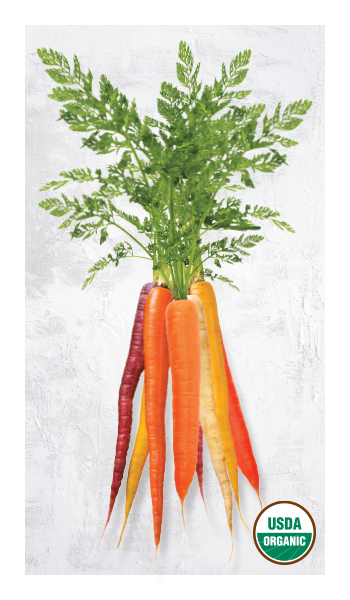


Sign-up for {N}power to get exclusive discounts, newsletters, members-only features, and more!
 Denver - Design District - Alameda and Broadway
Denver - Design District - Alameda and Broadway
368 S Broadway
Denver, CO 80209
United States
 Preferred Store:
Select a Store
Preferred Store:
Select a Store

Crème de Lite, Scarlet Nantes, Red Core Chantenay, Sirkana, Thumbelina, Imperator, Purple Dragon, Little Finger… though they sound like fine wines or heroes in a fantasy show, a carrot by another name is just as sweet! In hues of orange, purple, yellow and white, there are more than 40 varieties of wild and cultivated carrots grown around the world. So, grab an organic carrot of any kind and enjoy the crunchy sweet health benefits!
 Night Vision: True or False?
Night Vision: True or False?“Carrots keep you healthy and help you see in the dark.” Have you ever heard the rumour that eating carrots will give you night vision? It’s a bit of an exaggeration that started during WWII,1 but carrots do contain a number of compounds that support optimal eye health. Carrots are especially known as a potent source of carotenes. Beta-carotene for example, a precursor to vitamin A, is a vital nutrient for supporting eye function and immune health. Another reason to include carrots in your next meal? Carrots are a fantastic source of lutein, the most dominant carotene in brain tissue and vital to healthy eyesight, as it accumulates in the macula of the eye where it filters damaging blue light.2 3 While we may not get night-vision superpowers from eating carrots, the superpower of good health is worth a carrot or two… or more.
We often hear about microplastics in our oceans, but did you know microplastics have also made their way into our fruits and vegetables? A 2021 study found micro- and nano-plastics in carrot roots and leaves.4 Plastic is everywhere and enters agricultural systems through our water and wastewater systems, plastic mulches, and the degradation of plastic materials used in farming. Though more research is needed to learn how we can get these microplastics out of our food systems for good, choosing organic carrots grown in healthy, biodiverse soil promotes the wellbeing of all ecosystems, keeping the harm from other toxic chemicals like pesticides at bay.
Healthy soil is everything when it comes to growing optimally nutritious (and delicious!) fruits and veggies. Healthy soil is organic, with no pesticide or other harmful sprays, is biodiverse, and full of organic matter that helps to retain water and sequester CO2 from the atmosphere.5 When it comes to carrots, organic is the way to go. Conventionally grown carrots absorb large amounts of organochlorines and other harmful sprays right into the root that we eat .6 7 8 Additionally, organic carrots have proven to be more resilient to extreme weather than conventionally grown carrots.9 Choosing organic carrots helps maintain good health all around—for you, for the soil, for the planet—a superhero move if you ask us!
 Mexican-Inspired Carrot Fries Recipe
Mexican-Inspired Carrot Fries RecipeShake up Taco Tuesday with these Mexican-Inspired Carrot Fries! These crunchy-sweet carrot sticks have a spicy kick and make the perfect dipper for sour cream, guacamole, and salsa.
GET THE RECIPE


Sign-up for {N}power to get exclusive discounts, newsletters, members-only features, and more!
